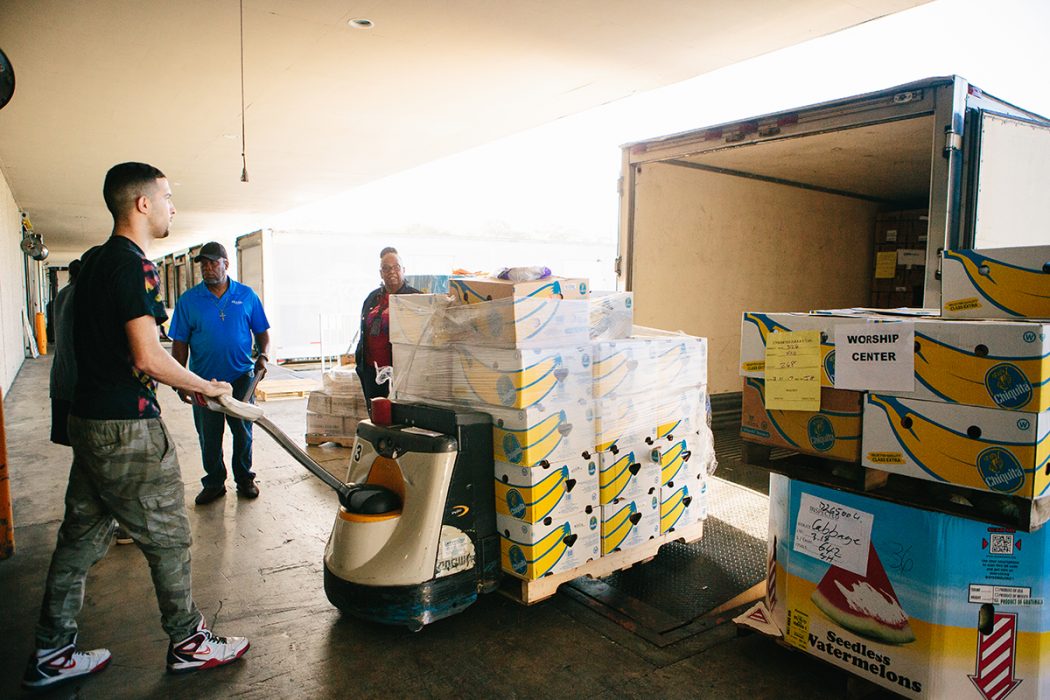There is no single human need greater than food, and because hunger triggers crime, and affects unemployment, worker productivity, and education, Feeding Northeast Florida is doing everything it can to feed low-income families with children, senior citizens, veterans, and the homeless in the eight counties that comprise Northeast Florida.
“Young minds can’t learn when they’re hungry, but in Northeast Florida more than 81,660 kids are food insecure,” said Kristen Anderson, director of communications for Feeding Northeast Florida. “One in six people in our community – 283,140 people in our region – doesn’t know where the next meal is coming from. Without our work, the staggering number of hungry neighbors will continue to climb, and our 160 hunger-relief partner agencies won’t have as many resources to provide critical services and the cycle of poverty will continue,” she said.
As a member of the Feeding America and Feeding Florida networks, Feeding Northeast Florida is the largest food bank in the region. It is one of 200 food banks within the Feeding America network nationwide. “We are the single-most efficient and cost-effective solution to nourishing hungry families,” Anderson said.
Serving Baker, Bradford, Clay, Duval, Flagler, Nassau, Putnam and St. Johns Counties, Feeding Northeast Florida takes in food donations, then weighs, sorts, and ensures the food is safe before delivering the goods to area food pantries. It also works to develop a network of satellite food distribution centers, such as Barnabas Center in Fernandina Beach or Trinity Christian Family Worship Center in St. Johns County, where perishable food can be stored in freezers and coolers to help with the logistics of food distribution throughout the region.
“We work hand in hand with our partner agencies to ensure our neighbors in need have access to high-quality food. No other organization distributes the volume of food that we do, has the reach that we do, or impacts this issue as vastly as Feeding Northeast Florida,” Anderson continued. “In 2016, we put nearly $10 million back into our community in economic impact. Our efforts saved our 160 partner agencies approximately $34.3 million in food costs. These partners, in turn, are able to invest those savings into breaking the cycle of poverty.”
Feeding Northeast Florida has four programs – The Mobile Pantry, Pantry Staple, SnackPacks and Senior Packs – that assist in getting food to people in need.
The Mobile Pantry program delivers fresh, refrigerated, and frozen items such as fruit, vegetables, dairy products, and lean meats to neighborhoods that do not have adequate grocery stores, or food pantries. In 2016, Mobile Pantry distributed approximately 1.7 million pounds of food.
The Pantry Staple program is a specialized service provided to many of Feeding Northeast Florida’s partner agencies. More than 20 unique, high-demand dry goods, which are not consistently rescued from Feeding Northeast Florida’s retail partners, are purchased then offered to the pantries and agencies at a deep discount compared to retail prices. This enables the agencies to focus their funding on other programs that support the food insecure.
The SnackPack program, developed in 2014 in coordination with Duval County Public Schools, serves children across multiple counties. Each kid-friendly pack contains two meals consisting of fruit cups, applesauce, cereal, trail mix bars, and healthy snacks. In 2016, 120,000 SnackPacks were delivered to children whose parents cannot consistently feed them on weekends. Unfortunately, due to a lack of funding, Feeding Northeast Florida has a waiting list of more than 2,000 children in need. More assistance from the community would allow the nonprofit to immediately increase its SnackPack distribution by 9,000 packs per month.
Senior Packs consist of 20 nutritious meals and are provided to 150 targeted food insecure seniors every other week. Last year, the packs were distributed only to Campus Towers, but Feeding Northeast Florida plans to expand the program to include three other food desert locations. Senior Packs are stocked with whole grain rice and pasta, assorted canned fruits, veggies, and proteins such as canned tuna and peanut butter.
Feeding Northeast Florida distributed 12.3 million meals through its community partners in 2016. Eighty-four percent went to families with children, while eight percent went to senior citizens and another eight percent went to veterans. From January through July of this year, more than 7.2 million meals were distributed. There are still 50.8 million meals needed to provide food to everyone who is hungry in the region, according to Feeding America’s Map the Meal gap study.
In 2014, the Feeding Northeast Florida food bank delivered its first load of food in the community, distributing 18,000 pounds of fresh produce and high-quality food to agencies such as City Rescue Mission, Trinity Rescue Mission, Beaches Emergency Assistance Ministry (BEAM), The Salvation Army, and The Sulzbacher Center. Within six months, the number skyrocketed to more than 4.6 million meals and has since climbed to where it is today.
The food bank partners with Publix, Walmart, Winn-Dixie, and Target, as well as Kellogg’s, Nabisco, and Tyson Foods, to obtain its groceries.
“On average, 70 billion pounds of food is wasted each year in the United States,” said Anderson. “When a box gets torn, a can dented, or an item’s expiration date is just too close to fetch full retail price, rather than have those things going to the landfill, the stock clerk pulls them off the shelves at night and sets them aside for us to pick up the next morning. When a farmer has potatoes that are misshapen or eggs that are too big to fit in the foam containers, those also come to us, often in the hundreds of thousands. We also receive donations from church, business, and school food drives,” she said.
Feeding Northeast Florida is also grateful for the monetary contributions given by board members, individuals, corporations and foundations, as well as an impressive number of volunteers on a recurring basis, said Anderson.
In 2016, approximately 10,773 volunteers invested 32,319 hours helping inspect and sort food for quality and freshness. It is a donation of time equivalent to 15 full-time employees. “Volunteers are the heartbeat of our operation,” Anderson said.
“Each day we distribute 34,000 meals. For every dollar donated, we can provide six meals,” Anderson said. “Hunger is not a supply issue, it’s a logistics issue. The challenge is raising money to build the infrastructure required to increase our distribution. An investment in Feeding Northeast Florida will help us meet the need in our community and help change the face of poverty. Together we are feeding a stronger tomorrow.”





